Lucky13
Forum Mascot
Have seen all kinds of threads on aircrafts but none on the engine itself. 
So, ALL things considered, which was the best aircraft engine of WWII? Was it a Rolls Royce, Pratt Whitney, Wright, Daimler Benz, BMW or? .....the list goes on.....
So, ALL things considered, which was the best aircraft engine of WWII? Was it a Rolls Royce, Pratt Whitney, Wright, Daimler Benz, BMW or? .....the list goes on.....

